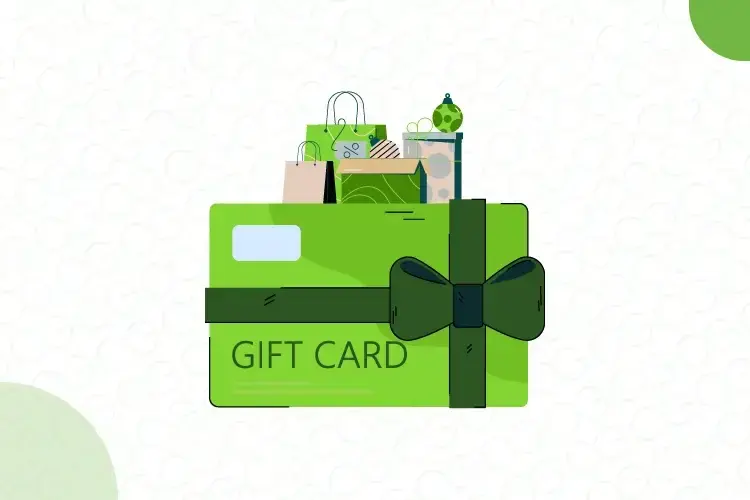Implementing Gift Cards for Boosting Retail Growth
Gift cards may be an age-old concept, but it continues to be a major factor behind retail success. This is why the gift card market is growing at a breakneck speed: the sector which was valued at $899.3 bn globally in 2021 is projected to hit a staggering $2.3 trillion by 2030.
In the last year alone, there has been a 12% spike in gift card purchases. However, the growth story around gift card doesn’t end there. The value loaded into the gift card has also grown significantly, clocking a whopping 7% rise just in the previous year. Behind the popularity of gift cards lies the fact that they are instrumental in attracting new customer and ensuring brand loyalty against competition.
Given that gift cards have been a long-standing marketing tool in the retail industry and continues to gain traction, in this blog, we will explore the following:
- Why are gift cards important in the retail industry?
- How to set up a gift card program?
- Different types of gift card programs and their benefits
- How does Ginesys help retailers make the best of gift cards?
Benefits of Gift Cards
Here are some of the advantages of a gift card program that can help retailers should know to make the best of the cards:

Want to leverage gift card for retail success?

Brand Loyalty
Gift cards, over the years, have proven to be of great help when it comes to fostering brand loyalty. A recent report has shown that 83% of consumers are willing to buy a gift card as a way of getting attractive discounts on their purchases. Once a gift card is issued, the buyers are likely to keep coming back in the hope of more offers. It has also been observed that 68% of consumers consider gift cards as their preferred type of incentive.
Customer Experience
Personalized CX (customer experience) has been deemed a major factor in fostering brand loyalty. When brands issue gift cards, they can ask for personal details such as mobile number, email, birthdays, and anniversaries. This way, companies can organically collect customer data and tally that with the transaction of the customer in question to send them “special day” offers or deals on preferred items via SMS or e-mail.
Locked-in Income
When a brand enrols a customer in the gift card program, the customer needs to preload the card with a certain amount of money. Regardless of how soon the card is used, the brand earns the money that is stored in the card. The profit from the cards is even higher when the voucher is not swiped, as the items the gift card targeted can be sold separately. To understand the impact gift cards have, let’s consider the retail scene in the U.S. Around $23 bn worth of gift card funds remain unspent, that is 47% of American adults have yet to redeem the vouchers.
Omnichannel Sales Promotion
As consumers are becoming more and more interested in e-commerce due to their busy lifestyles, gift cards can be an interesting way to promote omnichannel sales. To redeem the gift card amount, customers are likely to make more online purchases, thus helping the brand strengthen its virtual presence. Issuing and redeeming vouchers has never been more effortless since the advent of digital gift. A market research report has shown that millennials have been using digital gift cards more than any generation ever, making the generation an ideal audience.
Stock Clearance or Seasonal Sale
At the end of every season, retailers often run sales or discounts to stay liquid, acquire more inventory, and get rid of items that might lose value in the coming days. In this regard, gift cards can be an effective tool for driving blowout sales, as vouchers can target a specific kind of items in the inventory and enable brands in stock clearance.

Here’s how you can implement gift cards in your business

Additional Purchases
When customers go online or come to the store to use their gift cards, they are likely to come across other things which interest them or are of need. In other words, gift cards are a gateway for the customers to browse the items in the inventory more and make impulse purchases. A study has demonstrated that two-thirds of consumers are likely to spend 59% more than the gift card value, making the marketing tool a robust enabler of revenue growth.
Lean Operation
For retailers who are trying to run their businesses with a lean team, gift cards can be of great use. Vouchers are easy to use and can be redeemed easily, thus, they are perfect for self-checkout kiosks, enabling buyers to skip long queues and have a smooth shopping experience.
Leveraging Consumer Mindset
Vouchers trigger sales via a psychological impact. Often when people have paid for gift cards, they tend to consider the gift value to be free money, thus being more indulgent while making purchases. Regardless of how they have come to possess a gift card, 76% of consumers consider redeeming gift cards as an excuse to treat themselves. Of these 76% buyers, 80% are millennials, the future crop of consumers: this is why leveraging gift card programs is more important than ever.
Amping Brand Reach
Vouchers can be a potent tool for increasing reach, as consumers can share or send gift cards to their friends and family, boosting the company’s brand reach. According to a study, among 67% of consumers who were observed during the survey year, 59% bought the gift card for someone else. Gift cards can be seen as a thoughtful present as they indicate that the gift-giver understands the recipient’s preference. At same time, the card offers flexibility, as it allows the receiver to choose from a range of products they like.
69% of the people studied said that vouchers can be a great tool for employee engagement. This way retailers get more than the locked-in income from the amount spent in the gift card purchase. Companies can also access a wide range of audiences, who in turn may buy additional items that are not listed in the gift card program.
Promoting New Items
Brands that are seeking to expand their inventory and want to find out the viability of a new item can begin the journey with coupons or gift cards. A whopping 60% of buyers might try a new product if a coupon is offered.

Are you getting the most out of your gift card program?

A Guide for Retailers: How do Gift Cards Work?
To implement gift cards smoothly, retailers need to understand the onboarding and redemption process. In this section, we will throw a cursory glance at the two processes.
The Onboarding Phase
The following pointers show how retailers can implement a gift card program:
- An in-store employee or a piece of marketing communication informs the customer about the details and the benefits of the gift card.
- For in-store purchases of the card, the employee activates the card via the Point of Sale (POS).
- To avail a gift card online, customers can go to the retailer’s website and add it to the cart, followed by a virtual payment. While an e-gift card code is emailed instantly to the customer, physical cards are shipped.
- The transaction made for the gift card purchase as well as the redeemable value of the card is recorded by the POS.
The Purchase via the Gift Card
When using gift cards online, customers are required to enter the card's code or associated number at checkout. On the other hand, for in-store purchases a physical card can be scanned, swiped or the e-voucher’s code is entered in the POS system. Once the transaction is complete, a certain card value is deducted from the gift card's balance. Certain programs allow users to make partial payments via the card, particularly when the card balance is insufficient.
Worth noting that while implementing a gift card program it is important to set goals that the gift card program should achieve. The program objectives may include:
- The expected revenue returns
- The potential reach achievable through the program
- The ratio of purchase and redemption
Determining the aim of leveraging the card is helpful in designing the program, inventory planning around the program, setting the expiry date of the vouchers, and selecting the range of items available for offer via the card. As business goals change, the expected outcome and the details of the program are likely to be modified as well.
To effectively run a gift card program and onboard clients in the program, training one’s store staff to explain the features and merits of vouchers can proactively engage a significant number of customers.
Types of Gift Card and their Merits
Primarily, there are two kinds of gift cards, open-loop and closed-loop gift cards. While closed-loop cards are only applicable to a specific brand, open-loop gift cards help customers make discounted payments for a group of vendors.
Retailers should note that as opposed to open-loop gift cards, leveraging a closed-loop gift card means that the customer will return to the brand to spend the gift card amount.
Creating Awareness about the Gift Card Program
Here are key considerations for boosting the reach of a gift card program:
- To maximize the number of gift card sales, retailers must leverage both, online and in-person marketing strategies.
- When a customer is personally onboarded into the program by an employee, it becomes an opportunity for the brand to understand the client’s preferences and serve them accordingly.
- Incentivizing employees could be a good way to boost the sale of gift cards.
- In the case of online advertisements, retailers can effectively target diverse demographics at the same time and encourage snap purchases.
- When a gift card is added to e-mail marketing or SMS campaigns, it can help brands get better returns on their marketing investment as the audience gets enticed by an offer. Retailers can further personalize CX by offering customizable gift card options.
Metrics for Tracking the Success of Gift Card Programs
Retailers must keep a tap on the following to know the impact the gift program has made:
- The number of gift cards sold
- The value of cards and the number of cards used
- Making charges and the marketing costs of the cards
Among the POS software that enable easy use of gift cards, Ginesys’ solution is a noteworthy tool. In the next section of the blog, let’s explore how Ginesys POS can help retailers roll out a robust gift card program.

Does POS help you leverage a robust gift card program?
Leveraging Gift Cards with Ginesys POS
We understand that CX is one of the foremost factors behind the growth of a retailer and that discounts, coupons, and gift cards play a major role in delivering a smooth brand experience. This is why, to help retailer tackle an increasingly competitive market, we ensure that brands can effectively run gift card programs.
Ginesys POS is integrated with leading loyalty management software, empowering brands to issue and redeem gift cards in an effortless manner. Over the years, as we have worked with brands across sectors, both, Ginesys POS and Zwing Cloud POS have proven to be robust solutions towards fostering brand loyalty.
Key Takeaways
- Gift cards can play a major role in increasing sales and generating revenue, even if the card benefits are not redeemed.
- When used as a present, gift cards help brands boost their audience reach and potentially bring in new business.
- Gift card is an easy way to trigger impulse purchases and improve brand awareness and loyalty.
- Shopping sprees that include the use of gift cards can lead to additional purchases that are not covered by the card, prompting customers to try out new items.
- The onboarding process of gift card programs can help brands acquire client details which can later be used for personalized marketing efforts.
- For quick transactions (in-store or online), gift cards are helpful.
- Gift cards are easy to promote and enhance the outcome of email or SMS marketing campaigns.
Want to know more? Book a demo today!

